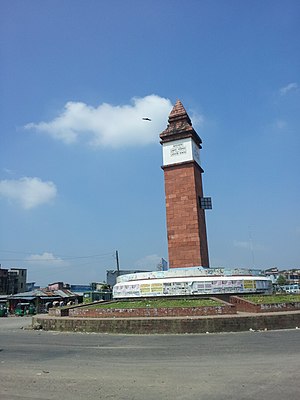Syed Qudratullah Sattar
| Moulvi Syed Qudratullah Sattar Munsef | |
|---|---|
| Native name | সৈয়দ কুদরত উল্লাহ ছাত্তার |
| Born | 1750 Gavindasri, Chowallish Pargana, Srihatta Sarkar, Bengal Subah, Mughal Empire |
| 💀Died | February 12, 1839 (aged 88–89) Bengal Presidency, British RajFebruary 12, 1839 (aged 88–89) |
| 💼 Occupation | Judge, moulvi, entrepreneur |
| Known for | Establishing Moulvibazar |
| 👶 Children | Khariza Bibi, Ariza Bibi (daughters) |
| 👴 👵 Parent(s) |
|
| 👪 Relatives | Shah Mustafa (ancestor), Syed Yasin (grandfather) |
| Family | Syed family |

Moulvi Syed Qudratullah Sattar Munsef, (Bengali: মৌলভী সৈয়দ কুদরত উল্লাহ ছাত্তার মুন্সেফ; born 1750) was a Bengali judge and entrepreneur. He is best known as the founder of Town of Moulvibazar, which is also the name for eponymous district and upazila in Bangladesh.
Early life[edit]
Qudratullah's father was Syed Hurmotullah, a son of Syed Shah Yasin. Yasin was the paternal nephew of Shah Mustafa - a Muslim preacher associated with spreading Islam to present-day Moulvibazar.[1]
Career[edit]
In 1771, at the age of 21, Qudratullah established a bazaar near the banks of the Manu River using his zamindari land. He started importing edible goods, such as fruits and vegetables opening up opportunities for people to purchase as well as sell. The location allowed easy access through river and land transport.[2] With his moulvi status, the local people named it as Moulvibazar after him.[3] Some sources mention the bazaar was established in 1810, however.[4]
In 1793, Qudratullah became a Munsif,[5] a local judge of a civil court (similar to the modern-day Indian District Munsiff Court) in Fenchuganj.[6]
Qudratullah passed away on the 12th of February 1839 at 89 years old.[7]
Legacy[edit]
The market, which gradually expanded over time to become a town, became headquarters of a South Srihatta (and later South Sylhet) subdivision/mahakuma (consisting of 26 parganas) by the British rule on 1 April 1882.[8] In 1918, the town was made a municipality and in 1930, a pourashava. In 1960, South Sylhet's name was simplified and named after its capital, Moulvibazar, by administrator Dr M A Sattar.[9] On 22 February 1984, the President of Bangladesh, H M Ershad, upgraded its sub-division status to a district as a part of his decentralisation programme.[10]
In 2015, a 5-storey municipal market mall containing up to 36 stores was opened and funded by the Moulvibazar Pourashava and World Bank.[11] The building was named after Moulvi Qudratullah Sattar and cost 300,000 Bangladeshi takas to establish.[12]
To this day, there is a road called Kudrat Ullah Road near Paschim Bazar, Moulvibazar.
See also[edit]
References[edit]
- ↑ Mujibur Rahman Mujib (10 January 2019). পীরে কামেল হযরত সৈয়দ শাহ (in Bengali). Patakuri.
- ↑ মৌলভী সৈয়দ কুদরত উল্লাহর বাজার থেকে মৌলভীবাজার. Bangla Tribune (in Bengali). 8 November 2018.
- ↑ "Itihash". Government of Bangladesh. Retrieved 24 September 2018.
- ↑ Dutta, Panna (9 Oct 2018). চায়ের দেশ মৌলভীবাজার (in Bengali). Odhikar.
- ↑ also spelt Munsiff or Munsef
- ↑ "Prokhkhat Bektito". Government of Bangladesh. Retrieved 24 September 2018.
- ↑ মৌলভী সৈয়দ কুদরত উল্লাহ'র ১৮০ তম মৃত্যুবার্ষিকী আজ. MKantho (in Bengali). 12 February 2019.
- ↑ ইসলামী বিশ্বকোষ [ISLAMI BISHWAKOSH: The Encyclopedia of Islam in Bengali, 21st Volume] (in Bengali). Dhaka, Bangladesh: Islamic Foundation, Bangladesh. September 1996. pp. 448–452. Archived from the original on 11 February 2016. Search this book on

- ↑ "Introduction". Moulvibazar.com. January 2016. Retrieved 4 September 2016.
- ↑ "Bhougolik Porichiti". Moulvibazar Gov. Retrieved 24 September 2018.
- ↑ Imad-ud-Din (28 October 2015). শুধু প্রতিশ্রুতি নয় কাজের মাধ্যমে জনগণের আস্থা অর্জনই লক্ষ্য. Manab Zamin (in Bengali).
- ↑ মৌলভীবাজারে ৩ কোটি টাকা ব্যয়ে পৌর মার্কেট ভবন. Banglanews24.com (in Bengali). 25 October 2015.
This article "Moulvi Syed Qudratullah" is from Wikipedia. The list of its authors can be seen in its historical and/or the page Edithistory:Moulvi Syed Qudratullah. Articles copied from Draft Namespace on Wikipedia could be seen on the Draft Namespace of Wikipedia and not main one.
